by Dorothea
Burstyn
(click on photos to enlarge image)
COLLECTING AUSTRIAN SILVER SUGAR TONGS
While English sugar tongs are available in a wide variety of
styles and in abundance from the early 18th century on, the
collector of Austrian sugar tongs is limited to 19th century
production from about 1820 to 1880, because a) due to the
draconian laws during the Napoleonic Wars very little old silver
escaped the melting pot and b) towards the end of the 19th
century silversmiths did not regard sugar tongs as single
serving pieces anymore but fashioned them as part of tea-and
coffee sets or larger flatware services.
 |
Fig. 1 Sugar tongs following the French
style: Prague before 1824
|
This is the oldest pair of
sugar tongs in my collection; it is a Prague example
dating to before 1824 (13 cm long, tax free stamp B
above F, Prague control mark 182?, master mark IL).
It clearly follows the French style of the period
even though it does not measure up to the elegant
sophistication and fine workmanship of the French
tongs. (14 cm, control and discharge Paris 1809-38,
master mark of Francois-Marie Lecour). Pierced
decoration of various flower and leaf motifs enjoyed
a long-lived popularity on Austrian silver and was
used on everything from plates to fruit baskets.
Fig. 2 Sugar tongs, Prague before 1824 and Paris
1809-38, master mark of Francois-Marie Lecour (on
the right)
|
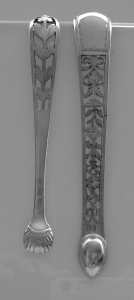 |
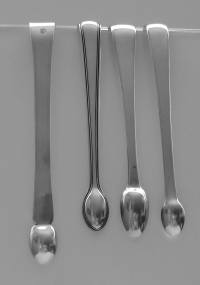
Fig. 3 A plain Austrian example, dating to Linz
1827 (left) looking almost like English tongs from
1800 to about 1820
|
Left is a plain Austrian
example, dating to Linz 1827 (14cm, master mark AR
conjoined) which looks almost like English tongs
from 1800 to about 1820. To emphasize this point
three English tongs are shown here: London 1801 by
George Wintle, London 1816 by Edward Fernell and
London 1810 by Wm. Eley, Wm. Fearn and William
Chawner. Due to the lack of extant examples,
meaningful remarks re Austrian sugar tongs of the
early 19th century cannot be made, and it is unclear
if French or English influences dominated. W.
Neuwirth shows yet another early type of Viennese
sugar tongs
(note 1) - specifically an 1817 plain
bow-shaped pair made by F. Würth with applied
medallions of classical allegoric figures. Generally
this style is more identified with sugar tongs
originating in German lands. Shown here is a
low-grade example with leaf-shaped grips and
decorated with an almost identical medallion as the
Würth tongs (marked 12, master mark "?IL", 16 cm)
and two other German sugar tongs with applied
medallions, one marked with master mark CFB only on
each arm (17cm) and the other marked 13 and master
mark D above FZ (15 cm). According to recent
research, these medallions were produced by
Bruckmann & Söhne, Heilbronn - a firm which made
many types of these findings and supplied them to
the trade
(note 2).
|
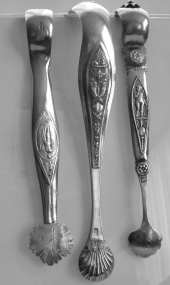
Fig. 4 An 1817 sugar tongs made by F. Würth with
applied medallion of classical allegoric figures (left)
and two other German examples with applied
medallion
|
From the 1830s on
distinctive Austrian styles were developed. Fig. 5
shows an exclusively Austrian type, featuring a flat
spring mechanism plus an additional steel spring
inserted between the sturdy arms. This pair is
marked on both arms with the Viennese control mark,
once overstamping the master mark, which was
obviously a mistake of the assay office. Maddeningly
both control marks are stamped in so sloppily so
that the production year is not fully legible - but
many sugar tongs of this type are known and
generally made around 1830.
|

Fig. 5 Sugar tongs featuring a flat spring
mechanism plus an additional steel spring inserted
between the sturdy arms
|
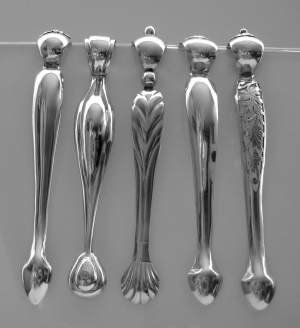 |
A popular style in use
about three decades from circa 1840 to 1870, are the
sugar tongs with bulbous - shaped arms, the bow
often separated from the arms by little silver
spheres. From left to right is a plain unmarked
example with an inside inscription 1824/1851 - maybe
an anniversary present, a Viennese example dating to
1844, master mark TD, another one dating to 1850,
master mark MK and two sugar tongs made by Christian
Sander, stamped with the early Diana head control
mark in use from 1866-1872. This style is also often
decorated with round disks on top of the bow, with
either chased or die-stamped decoration featuring a
middle knob so typical for all types of Austrian
sugar tongs. A wide range of decoration is found:
pierced, flat chased or engraved, but they were also
made plain or with various folds in their bulbous
shaped arms.
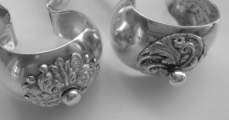 |
Fig. 6 Sugar tongs with bulbous - shaped arms
|
Fig. 7 Sugar tongs decorated with round disks on
top of the bow
|
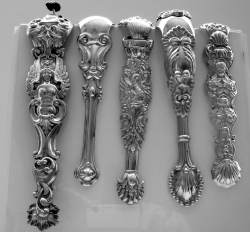
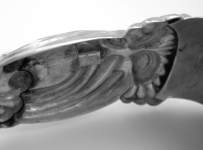
|
From about 1840 over-sized
sugar tongs - up to 31 cm! - pressed or die-stamped
out of thin sheets of silver with remarkably
intricate designs became popular. Swans, angels,
roses, acanthus leaf or complicated scroll patterns
abound. Cheaply produced, they instantly increased
the circle of consumers. Now even members of the
lower middle class could afford a silver piece,
acquiring with it the illusion of being surrounded
by fine and expensive utensils previously reserved
for the upper classes. Shown here from left to right
is a Viennese pair, dating to 1856, master mark AB,
with cast flower finial - maybe matching an equally
elaborately decorated sugar casket, another Viennese
pair, control mark 1852, master mark AB in a
complicated swan pattern, a Viennese example made by
the same master (AB), dating to 1865 featuring a
pseudo-baroque scroll pattern and two examples by
Jacob Weiss, one Vienna 1840 and a 183? example
decorated with the ever popular rose decor. These
excessive concoctions are items which have become
almost nonfunctional, and whose only purpose must
have been to serve as showy prestige items on the
Sunday coffee table. Most of these tongs are
equipped with steel springs, inserted devices which
serve as protection mechanism against over-extending
the arms. Even if tongs of this type are found
without steel springs, the little brackets inside
the arms are proof that they just have been lost.
Thin and flimsy, these types of sugar tongs are
seldom found without repairs, since they are
naturally prone to breaks and splits.
Fig. 8 Over-sized sugar tongs with remarkably
intricate designs (top left)
Fig. 8A The little brackets inside the arms proofing
that the steel springs have been lost (bottom left)
|
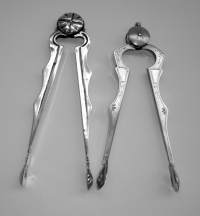
Fig. 9 Two compass-shaped sugar tongs
|
The sober styling of the
compass-shaped sugar tongs must have been a welcome
relief for customers who looked for simpler designs.
Even though introduced around 1850, most of the
compass shaped sugar tongs date to after 1866. Flat
chased, acid etched or engine turned, their
decoration matches contemporary coffee- and tea sets.
They all have hollow arms and a spring mechanism in
a disk-shaped casket; some are equipped with knob
finials. Fig. 9 shows an early example (16.5 cm),
Viennese control mark for 185? with shell-shaped
grips, the other pair features bright-cut decoration
and is unmarked except for two later bird's wing
marks. Fig. 10 shows an engine turned example,
marked with the early Diana head for 1866-72, and
two small assay office remarks for Vienna,
apparently no master mark (17 cm) and an acid-etched
and engraved pair (16 cm), Diana head mark
1866-1872, master mark JZ and two tiny illegible
assay office remarks.
|
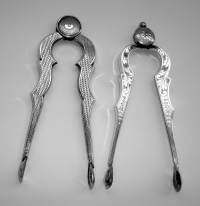
Fig. 10 An engine turned example and an
acid-etched and engraved pair
|
Filigree sugar tongs were
made throughout the century; the filigree workers
had their own guild and their wares were almost
never marked. Austrian sugar tongs are distinctive
though as they are entirely formed of densely worked
filigree sections, only the grips and little plaques
- providing a place for monograms - are solid
silver.
For style comparison two typical German filigree
tongs (on the right) are shown, one is stamped
BERNING and 12, next to a silver-gilt pair made in
Nuremberg by Johann Samuel Schönberg, ca.1820.
Note the much looser filigree patterns soldered into
solid silver frames. Most of the German filigree
tongs are marked.
Fig. 11 Two Austrian Filigree sugar tongs (on
the left) and two German filigree tongs (on the
right)
|
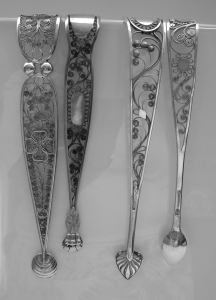
|
There are always a few pieces in a collection which cannot
be neatly put into one category or the other. Fig. 12 shows a
one-of-a-kind type, marked with Viennese control marks 18?8,
master FT, 18 cm, it weighs a whopping 84.7 g. (Compare this to
the 58.5 g of the angel-patterned, 31 cm long, sugar tongs shown
in Fig.8) A spring mechanism is fitted into a rectangular box
with knob finial. The arms are curved in a pseudo baroque style;
the grips are four leaf clover-shaped just like the ones of
another extravagant example, Fig.13, 17.5 cm long and marked
with unclear control marks for 18?7, double eagle and master
mark HE.
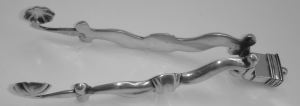 |
 |
Fig. 12 One-of-a-kind type, marked with
Viennese control marks
|
Fig. 13 An extravagant example marked with
unclear
control marks for 18?7
|
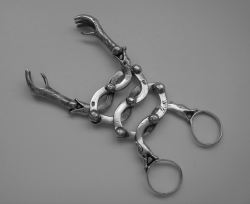
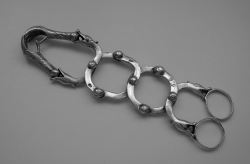 |
A novel construction
features an intricate snake pattern ending in two
claws, which extended measures 16.5 cm. It is only
marked with the recharge mark for Krakow 1806, so
must have been made before this date. The elegant
engine turned example (19.5 cm extended) dates to
after 1872, master mark not legible. In American
silver terminology this type is called "lazy tongs"
(note 3), and enabled the user to reach
food on the farther side of the table. It is up to
discussion if the tongs shown here were used as
sugar tongs. But in any case, since they are
interesting as novelties, I wanted to include them
here.
(left) Fig. 14 and 14A Sugar tongs featuring an
intricate snake pattern ending in two claws
(right) Fig. 15 and 16 Engine turned sugar tongs of
the type called in American silver terminology "lazy
tongs"
|
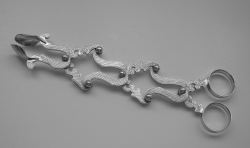
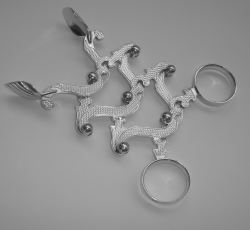 |
In ending a few words about Austrian silver marks:
From 1806 the assaying of silver has been executed by the
Austrian Mint in its various assay offices. Silver is marked
with a maker’s mark and an official assay office mark (control
mark). The mark is called "Radlpunze" for its resemblance to a
wheel. Two standards of silver were allowed, the common 13 lötig/812.5
fine (Fig. 17) and the more rarely used 15 lötig/937.5
fine (Fig. 18). Only the mark of 1813 employs a scalloped
lower surround (Fig.19). From 1814 to 1866 the form of
the Radlpunze (Fig. 20) remains the same.
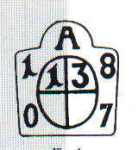 |
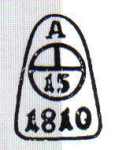 |
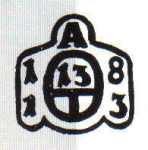 |
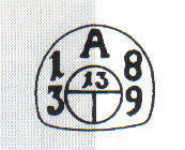 |
Fig. 17: 13 lötig/812.5 fine mark
|
Fig. 18: 15 lötig/937.5 fine mark
|
Fig. 19: 13 lötig/812.5 fine mark
employing a scalloped lower surround (1813)
|
Fig. 20: Radlpunze (1814-1866)
|
Silver made prior to 1824 includes various recharge marks
and tax free marks – a detailed discussion of these marks is
omitted here, since sugar tongs bearing these marks are
extremely rare. One of the most appealing features of the
Radlpunze is that it contains information about the production
place and year. In this connection it is important to know that
the mark for 1807 was in use until 1809, the mark for 1810 was
used until 1812, and the one for 1840 until 1842
(note 4). Consequently, all items bearing the year
marks of 1808, 1809, 1811, 1812, 1841, and 1842 can be regarded
as fakes. Faked sugar tongs are literally unknown, but the
so-called China silver mark should be mentioned (Fig. 21).
This mark completely
resembles the Radlpunze but features instead of the
13 the letters CH. The mark was introduced by a big
Viennese firm at the trade exhibition of 1844 and
was used to mark plated wares. This information
might be only of academic interest; I have not
encountered any "China-silber" during more than 30
years of collecting. Still, items with this mark
seem to be on the market - one pair of sugar tongs,
bearing this mark next to a GS mark is shown in
Neuwirth's Wiener Silber 1780-1866
(note 5).
|
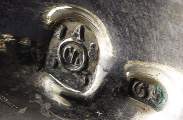
Fig. 21: China-silber mark
|
From 1866 silver is stamped with the Diana head mark and
master mark. From 1867 - 1872 small control stamps for the
various assay offices were stamped next to the earlier Diana
head mark. Puzzling is the marking of some obviously antique
sugar tongs with two bird wing’s marks, which was in use after
WWI for foreign silver. A 1954 order of the Austrian Ministry of
Finance decreed that the mark for foreign silver should be
stamped on all private silver which came into the trade after
1954
(note 6). Most of the master marks are two or three
capital letter combinations, but single letter maker’s marks
also exist. No regulation ordering the uniqueness of master
marks existed; therefore the definite ascription of a master
mark is sometimes difficult. Some masters stamped their wares
with full name marks, but this applies rarely to sugar tongs.
The double eagle next to the master mark was a privilege given
to firms which served as purveyor of the court. But the double
eagle was also used as part of the mark of firms which were
registered companies or had a national factory authorization.
The quality of the items usually points the collector in the
right direction in this respect. This is only a very short
summary of data which are known about Austrian silver marking.
Much new research has been published. Interested collectors may
want to consult the bibliography below for further study.
ENDNOTES
1) Waltraud Neuwirth: Wiener Silber 1780-1866, Vol.II,
page 422/423
2) Bruckmann & Söhne, Silber aus Heilbronn für die Welt, 1805
– 1973,(Silver from Heilbronn for the world) Exhibition
catalogue 2002, page 86
3) William P. Hood Jr. et al: Tiffany Silver Flatware
1845-1905: When Dining Was an Art, Woodbridge, Suffolk,
2000, page 166, Fig. 249
4) Reitzner, Viktor: Edelmetalle und deren Punzen, Vienna
1952, page 228
5) Neuwirth, ibid, page 450, Fig. 751
6) Neuwirth, ibid, page 415
BIBLIOGRAPHIY
- Knies, Karl: Die Punzierung in Österreich, Vienna 1896
___________: Wiener Goldschmiedezeichen, Vienna 1905
- Latour, Graf Vinzenz: "Altes Wiener Silber" in Kunst und
Kunsthandwerk, 1899, p. 417 f.
- Neuwirth, Waltraud: Wiener Gold- und Silberschmiede
1867-1922, 2 volumes, Vienna 1976/77
___________________: Wiener Gold- und Silberschmiede
1781-1822, 3 volumes, Vienna 1996, 2000, 2001
___________________: Wiener Silber 1780-1866, Vol.1
Snuffboxes, 1988
___________________: Wiener Silber 1780-1866, Vol.II: Sugar
Castors, Sugar Bowls, Sugar Vases, Sugar Tongs, Vienna 1989
___________________: Wiener Silber, Viennese Silver,
Namens-und Firmenpunzen 1781 - 1866, Makers’ and company marks,
Vienna 2002
___________________: "Wiener Silber, Anmerkungen zu Namens-
und Firmenpunzen", in Weltkunst, 15.October 1998
- Parenzan, Peter: Ehemalige Hofsilber- und Tafelkammer,
Vienna, Bundesmobiliendepot, 1986
- Rohrwasser, Alfred: Österreichs Punzen, Edelmetall
Punzierung von 1524-1987, Vienna 1987
- Schmuttermeier, Elisabeth: Wiener Gold- und Silberschmiede
von 1781 bis 1921 und ihre Punzen/ Viennese Gold- and
Silversmiths from
1781 to 1921 and their marks, MAK, Vienna 2005, CD
Dorothea Burstyn is the Editor of the Silver Society
of Canada Journal
and Administrator of SSC website
http://www.silversocietyofcanada.ca
- 2009 -
|
|
|
 ASSOCIATION OF SMALL COLLECTORS OF ANTIQUE SILVER
ASSOCIATION OF SMALL COLLECTORS OF ANTIQUE SILVER





















